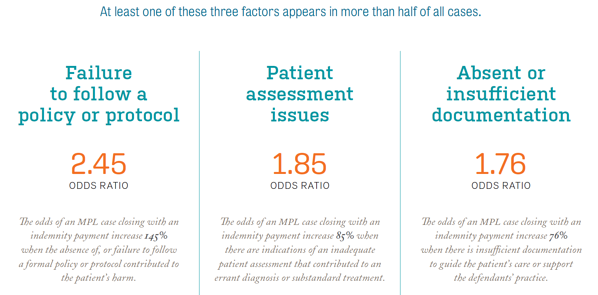Turning avoidable patient harm into evidence-based risk management is a key tenet of the evolving field of safety science. This tenet serves our corporate mission of protecting providers and promoting patient safety.
Each year we publish a report that analyzes our Comparative Benchmarking System (Candello). Candello represents more than 30 percent of all US medical malpractice claims and—very uniquely—includes open and closed claims, as well as paid and unpaid claims. Our new Candello Report, The Power to Predict: Leveraging Medical Malpractice Data to Reduce Patient Harm and Financial Loss, identifies which breakdowns in clinical processes are the strongest predictors of indemnity payments in malpractice cases.
This Report focused on which factors make malpractice claims more likely to pay—and how much. This is possible for two main reasons: 1. Candello data includes paid and unpaid claims, 2. Candello data includes contributing factors that codify issues that have statistically significant impact on case resolution.
In our own work, we rely on the statistical power of Candello to look deeper into claims data and gain valuable insights. These insights are used to:
- Target our patient safety risk reduction efforts
- Sharpen insurance pricing to closely reflect exposure
- Make informed underwriting and coverage decisions
- Determine how to allocate claims management resources more effectively
PREDICTIVE MODELING
CRICO has used predictive modeling for years, as have others in the medical professional liability (MPL) space. We look at our loss history and try to predict risk in various ways. We look at data and it reinforces something we thought or pushes us to look at something in a different light.
But we often put upon ourselves the responsibility to get it right based on our own experience and judgment. Many times, if not most, seasoned and talented professionals will be right. But to think any individual can capture, store, sort, and correlate the many factors that exist within and between cases of harm and loss—and get it right every time—is an unfair expectation.
Data that contains the many factors and dimensions of harm and loss—and statistical models that sort, correlate and make sense of them—should be an MPL professional’s new best friend. That said, data and analytics do not make decisions. Those must be made by professionals, and with confidence and maximum reliability. For this reason, data and analytics are mission critical to CRICO.
For this Report, we built a predictive data model on the likelihood that a claim will close with payment, and how much, given the clinical factors that enabled the event behind the claim to occur in the first place. To do this, the model explored the relationship between categories of contributing factors and the odds of a case closing with an indemnity payment. (Again, this is only possible because of the open and closed cases that are coded in Candello.)

APPLYING THE INSIGHTS
An example of how we use the insights from this Report can be seen in cases that involve a patient fall. Historically, we have not invested in fall prevention because they seemed to be a low cost/risk, based on experience, instinct and assumptions. However, the analysis in this Report demonstrates that there are conditions in which a fall claim can be quite expensive: failure to have or follow a policy or protocol.
“The odds of cases involving a patient fall closing with payment are 204% greater when there is a problem with a policy or protocol compared to falls-related cases without this factor.”
In fact, the odds of cases involving a patient fall closing with payment are 204% greater when there is a problem with a policy or protocol compared to falls-related cases without this factor. This shows us a potential path to be able to reduce the risk of high-value patient fall cases: ensure the institution has a fall policy and that it is being followed. This could help mitigate high-value fall cases as well as have a positive effect on the general reduction of falls.
While medical malpractice cases are often seen at ground level as rare, tragic, and costly anomalies or statistical outliers, the view from elevation is quite different. As in the case of patient falls, when aggregated, careful and deep analyses of MPL claims reveal often surprising evidence-based failures in systems and processes that lead to these claims. Yet, these are often the same failures that contribute to adverse events, sub-optimal care, dissatisfied patients, and operational breakdowns—problems that happen with far greater frequency, but which are hard to wrangle statistically. The fact that these failures were discovered or validated through malpractice data is neither here nor there. If unmitigated, the risks underlying these claims are likely to wreak further havoc across organizations.
DOWNLOAD THE REPORT
Leveraging the power of medical malpractice claims to reduce patient harm and financial loss seems a fitting title for this Report. It is what CRICO has done for more than 40 years and continues to promote through its use of advanced analytics.
I encourage all MPL insurance leaders and health system executives investing in reducing patient harm and financial loss to read this Report and think about how you can use predictive analytics with your data. MPL data has traditionally been leveraged for patient safety and loss prevention. But, if you have a large enough data set, applying predictive analytics is a powerful tool to support your core businesses of underwriting and claims management, too.

